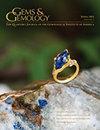红宝石的地理来源测定
IF 1.6
3区 地球科学
Q2 MINERALOGY
引用次数: 13
摘要
2019年冬季宝石与宝石世界红宝石市场在现代发生了巨大变化,尤其是在过去十年中,随着莫桑比克红宝石开采的发现和发展(Chapin等人,2015)。随着宝石贸易见证了红宝石供应链的动荡和戏剧性变化,地理起源的概念对买卖优质红宝石的人来说变得越来越重要。通常,红宝石的原产地对宝石的价值起着重要作用,尤其是来自缅甸的优质红宝石(图1)。与其他彩色宝石一样,红宝石贸易在很大程度上依赖于声誉良好的宝石学实验室来确定这些原产地。在本系列的第二篇具体材料文章中,我们深入研究了红宝石的世界、它们的宝石学特性以及可能有助于确定地理起源的特征。以下各节将详细介绍GIA为红宝石收集的起源数据,并描述实验室将这些数据应用于地理起源工作的方法。本文章由计算机程序翻译,如有差异,请以英文原文为准。
Geographic Origin Determination of Ruby
GEMS & GEMOLOGY WINTER 2019 The world ruby market has changed dramatically in modern times, especially in the last decade with the discovery and development of ruby mining in Mozambique (Chapin et al., 2015). As the gem trade has witnessed turbulent and dramatic changes in the ruby supply chain, the concept of geographic origin has become increasingly important to people buying and selling fine rubies. Often, the origin of a ruby plays an important role in the value placed on the stone, especially for exceptional quality rubies from Myanmar (figure 1). As with other colored gemstones, the ruby trade relies to a large extent on reputable gemological laboratories to make these origin determinations. In the second material-specific article of this series we delve into the world of rubies, their gemological properties, and characteristics that may aid in geographic origin determination. The following sections will detail the origin data GIA has collected for rubies and describe the methodology used in the lab to apply this data to geographic origin work.
求助全文
通过发布文献求助,成功后即可免费获取论文全文。
去求助
来源期刊

Gems & Gemology
地学-矿物学
CiteScore
2.90
自引率
19.20%
发文量
10
期刊介绍:
G&G publishes original articles on gem materials and research in gemology and related fields. Manuscript topics include, but are not limited to:
Laboratory or field research;
Comprehensive reviews of important topics in the field;
Synthetics, imitations, and treatments;
Trade issues;
Recent discoveries or developments in gemology and related fields (e.g., new instruments or identification techniques, gem minerals for the collector, and lapidary techniques);
Descriptions of notable gem materials and localities;
Jewelry manufacturing arts, historical jewelry, and museum exhibits.
 求助内容:
求助内容: 应助结果提醒方式:
应助结果提醒方式:


